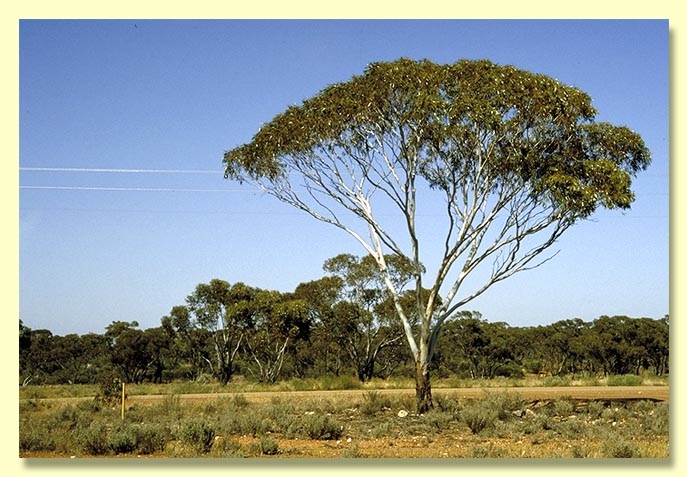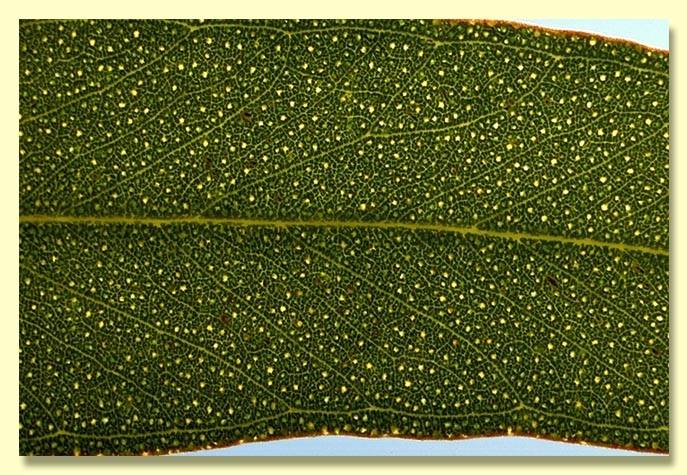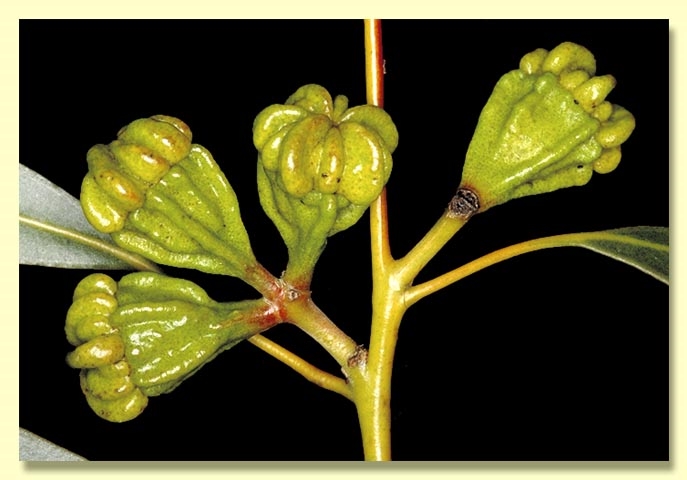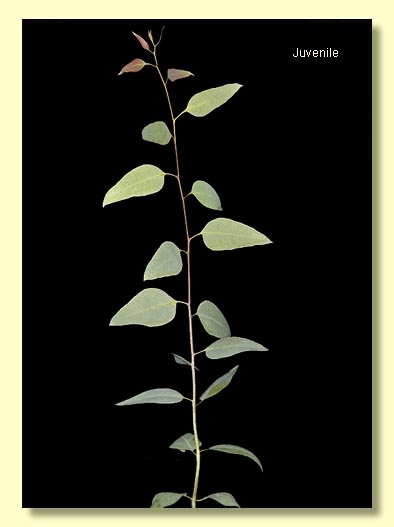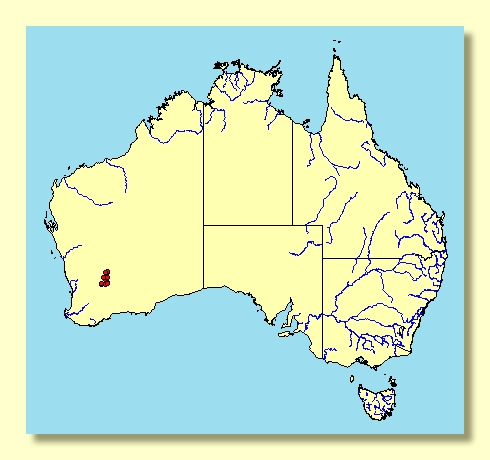Euclid - Online edition
Eucalyptus corrugata
Eucalyptus | Symphyomyrtus | Dumaria | Corrugatae
Bark usually rough dark grey to brown or yellow brown and scaly, flaky or thinly fibrous for up to 2 m of trunk, smooth above grey over salmon pink, sometimes prickly.
Branchlets usually glaucous; pith glandular.
Juvenile growth (coppice or field seedlings to 50 cm tall): stems rounded in cross-section, glaucous; juvenile leaves always petiolate, opposite for only the lowest node then alternate, ovate, 5.5–9 cm long, 2.5–4 cm wide, glaucous.
Adult leaves alternate, petioles 1.2–2.5 cm long; blade lanceolate or sometimes falcate, (7)9–13 cm long, 1.2–2(2.4) cm wide, base tapering to petiole, margin entire, apex pointed, concolorous, very glossy, mid-green, side-veins usually greater than 45° to midrib, sometimes acute, reticulation very dense, intramarginal vein remote from margin, oil glands numerous, intersectional, large and small.
Inflorescence axillary unbranched, peduncles 0.7–1.8 cm long, buds 3 per umbel, pedicels 0.4–0.8 cm long. Mature buds globular to pyriform in outline and prominently longitudinally corrugated (1–1.8 cm long, 0.9–1.3 cm wide), non-glaucous (but peduncle and pedicel often waxy), scar present, operculum rounded or narrowly flattened (0.4–0.8 cm long), stamens inflexed, anthers wedge-shaped, versatile, dorsifixed, dehiscing by longitudinal slits, style long and straight, stigma more or less rounded, locules 4, the placentae each with 4 vertical rows of ovules. Flowers white.
Fruit pedicellate (pedicels 0.3–0.5 cm long), cupular to obconical and ribbed, 0.7–1.5 cm long, 1.1–1.8 cm wide (including ribs), non-glaucous or waxy at very base only, disc level or descending, valves 4, usually strongly exserted.
Seeds dark brown, 1.5–2.5 mm long, ovoid to flattened-ovoid, dorsal surface pitted and margin noticeably irregular, hilum ventral.
Cultivated seedlings (measured at ca node 10): cotyledons reniform; stems square or rounded in cross-section, often glaucous; leaves always petiolate, opposite for 3 to 5 nodes then alternate, ovate to broadly lanceolate, 5–10 cm long, 2–4.5 cm wide, grey-green or slightly glaucous.
Flowering has been recorded in October.
A small to medium-sized tree or rarely mallee endemic to Western Australia, restricted to the eastern part of the central wheatbelt and adjacent areas of the goldfields, in an area bounded by Westonia, Mt Jackson, Kalgoorlie and Marvel Loch. The bark is rough, thick, grey-black at the base and smooth above. The adult leaves are very glossy green.
Eucalyptus corrugata belongs in Eucalyptus subgenus Symphyomyrtus section Dumaria because the buds have two opercula, stamens are strongly inflexed, ovules are in four rows on the placentae and cotyledons are reniform. Within this larger grouping E. corrugata and five other species—E. melanoxylon, E. concinna, E. brachycalyx, E. griffithsii, E. rugosa and E. laevis—form a subgroup called series Corrugatae, all with ovoid, conspicuously pitted seeds and with dark brown oil glands in the pith of the branchlets.
E. corrugata is distinguished from its near relatives by the combination of coarsely ribbed buds and fruits in umbels of three and tree habit. It may also be confused with the more distantly related E. tenuis and E. pterocarpa of Eucalyptus series Rufispermae, both of which have ribbed fruit, but these two species are smooth-barked and have shiny reddish seeds that are not pitted.

